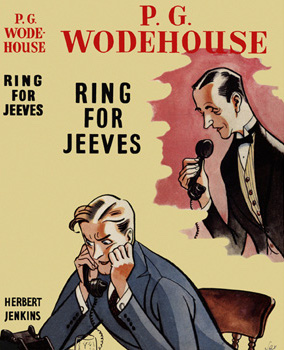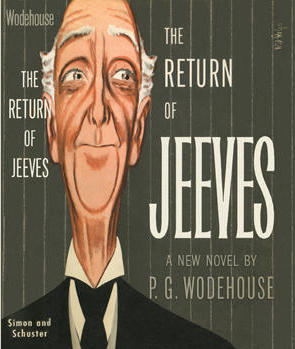Ring for Jeeves
(The Return of Jeeves)
by
P. G. Wodehouse
Literary and Cultural References
This is part of an ongoing effort by the members of the Blandings Yahoo! Group to document references, allusions, quotations, etc., in the works of P. G. Wodehouse. These notes, a work in progress, are by Neil Midkiff, with contributions from others as credited below.

 The first British edition, titled Ring for Jeeves, was published on 29 April 1953 by Herbert Jenkins Ltd., London. The first American edition, titled The Return of Jeeves, was published on 15 April 1954 by Simon and Schuster, New York.
The first British edition, titled Ring for Jeeves, was published on 29 April 1953 by Herbert Jenkins Ltd., London. The first American edition, titled The Return of Jeeves, was published on 15 April 1954 by Simon and Schuster, New York.
This novel has a complicated history. It began as a play by Guy Bolton and Wodehouse, published in an acting edition as Come On, Jeeves in 1956, but completed by July 1952, although still unproduced when Wodehouse converted it into a novel. (The play is included in Four Plays, Methuen, 1983.) In the play, the male lead, Bill, is the Earl of Towcester, residing at Towcester Abbey, and the Chief Constable of the county appears in Act III. The real-life town of Towcester (pronounced “toaster”) is in Northamptonshire. Publisher Jenkins sent a draft of the novel to the Chief Constable of Northamptonshire to see if he objected to a fictional character having that title; he threatened a lawsuit, so Bill became the Earl of Rowcester (pronounced “roaster”) at Rowcester Abbey in the county of Southmoultonshire for the British book. In the American book, The Return of Jeeves, the Towcester name was retained from the play, but the county became Southmoltonshire except for one reference in chapter 3, “all the way from Epsom Downs to Northamptonshire.”
An additional complication is the revision of the order of the first few chapters. The American edition begins by introducing Towcester Abbey and its inhabitants at the start of chapter 1; the British edition introduces Rowcester Abbey and its inhabitants at the start of chapter 2. The British edition opens at the Goose and Gherkin, with Mrs. Spottsworth meeting Captain Biggar, in chapter 1; that scene is chapter 5 in the American book. The American book’s first four chapters are essentially the same as chapters 2–5 of the British book. From chapter 6 onward the two editions run essentially in parallel. Since the play opens at Towcester Abbey, it seems that the American book edition follows Wodehouse’s original sequence; any reason for its reordering for the British book is unknown.
The story takes place after World War Two, and is thus out of the sequence of the other Bertie & Jeeves novels. Indeed, Bertie is offstage, as he is in the play, at a school “teaching the aristocracy to fend for itself” in a future without servants. In early drafts of the play, the butler at Towcester Abbey was named Ponsonby; Wodehouse thought “Why not make it Jeeves?” but later regretted using Jeeves without Bertie. In a letter (June 25, 1953) to William Townend, he wrote: “But it would have been better without Jeeves. It’s odd about these ‘double acts’. You need the stooge. Sherlock Holmes wouldn’t have been anything without Watson.”
More details and a synopsis of the play are in Nothing Is Simple in Wodehouse by Tony Ring (Harebrain Publishing, 2021).
Page references in these notes are based on the British text of the Autograph Edition, published by Jenkins in 1963, in which the text runs from p. 7 to p. 176. Somewhat confusingly, although conveniently, this British edition has been reprinted in trade-sized paperback by Harper Perennial Library (1990) with the American title The Return of Jeeves (ISBN 0-06-096502-9). [Still more confusingly, the rack-sized paperback of The Return of Jeeves from Harper Perennial (1985) uses the American text.] A table of correspondences between the pagination of several available editions will open in a new browser window or tab upon clicking the link.
* 1 *
(p. )
(p. )
(p. )
(p. )
(p. )
* 22 *
(p. )
(p. )
(p. )
(p. )
(p. )
Originally posted 2024-10-01 NM
Wodehouse’s writings are copyright © Trustees of the Wodehouse Estate in most countries;
material published prior to 1930 is in USA public domain, used here with permission of the Estate.
Our editorial commentary and other added material are copyright
© 2012–2025 www.MadamEulalie.org.